Ecological and Urban Agriculture
Background
The whole problem of health, in soil, plant, animal and man [is] one great subject.
– Sir Albert Howard
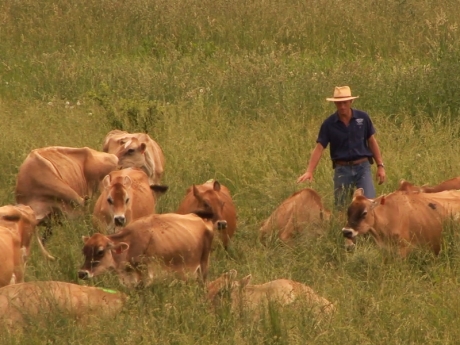
Dairy herd on an organic farm.
“Once plants and animals were raised together on the same farm—which therefore neither produced unmanageable surpluses of manure, to be wasted and to pollute the water supply, nor depended on such quantities of commercial fertilizer. The genius of American farm experts is very well demonstrated here: They can take a solution and divide it neatly into two problems.” – Wendell Berry1
Screen capture from Out to Pasture (2010), Johns Hopkins Center for a Livable Future and the Maryland Institute College of Art.
The 20th century saw the rapid growth of industrial agriculture—a model of farming characterized by specialization, mechanization, a heavy reliance on chemical and pharmaceutical inputs, and a shift toward fewer and larger farms. In many countries, including the U.S., the industrial model has become the dominant one.
Partly in response to the health and ecological problems of industrial agriculture, a growing movement of farmers have adopted alternative approaches to producing food. These go by many names, such as sustainable, ecological, and organic. The approaches often overlap, and in some cases borrow ideas from the industrial model. These approaches are hardly new; principles of agroecology were developed over thousands of years. Farmers are revisiting and refining these approaches based on new insights, new technology, and new challenges, such as climate change.
The breadth of different approaches to producing food raises questions as to which set of practices is best. The challenges in agriculture, from feeding the world to sustaining our capacity to feed future generations, are varied and complex. Addressing these challenges will likely require not one single tactic but a diversity of methods—each unique to time, place, and culture—that are as varied as the problems they aim to solve.
Sustainable Agriculture
Sustainability is a journey, an ongoing process, not a prescription or a set of instructions. ... [Sustainable agriculture] requires that we envision the challenges and changes the future will bring.
– Fred Kirschenmann2
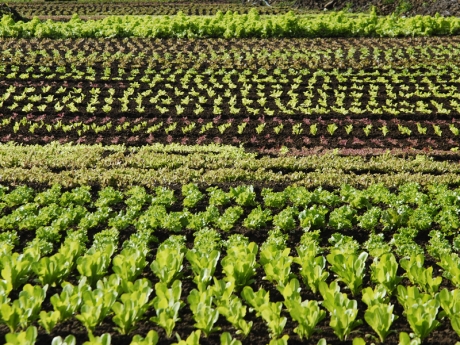
Crop diversity offers an ecological alternative to relying on pesticides.
Insect pests, such as corn earworms and cabbage loopers, tend to favor certain crops. Growing the same crop over a large area (monoculture) presents the opportunity for these pests to thrive and multiply on a bonanza of their “favorite” crop. Growing a variety of different crops and rotating them over time, however, helps keep pests in check.
Photo copyright.
Sustainability has been described as “meeting the needs of the present generation without compromising the ability of future generations to meet their needs.”3 Some approaches to agriculture, such as USDA Organic, are defined by a specific set of prohibited farming practices. Sustainable agriculture, by contrast, is only loosely defined, often based on three criteria:4
- Ecologically sound, e.g., conserving fertile soil, freshwater, and other natural resources. Practices that erode these foundations of agriculture are not sustainable over the long term.
- Economically viable, e.g., productive enough to provide farmers with an adequate living. If farmers are drowning in debt, they are probably on an unsustainable path.
- Socially responsible, e.g., promoting the health and wellness of farm workers and rural communities, and providing people with safe, nutritious food.
So what does sustainable agriculture look like in practice? It depends. Mother Goose Farms is a five-acre coffee orchard in Hawaii. The island’s mild climate is well-suited for coffee trees. Because the land is sloping, tilling it would quickly erode the soil; growing perennial trees avoids this problem. The trees also provide habitat for wildlife. The farm is certified organic, so instead of using herbicides, the farmers raise geese that waddle through the orchard eating weeds (and fertilizing soil with their droppings). The farmers process their own coffee and sell it directly to local customers, bypassing middlemen and allowing them to capture more of the revenue.5 But what is sustainable in Hawaii might not be sustainable in Iowa—the sustainability of a farm is rooted in its own unique ecosystem, culture, and economy.
Agroecology
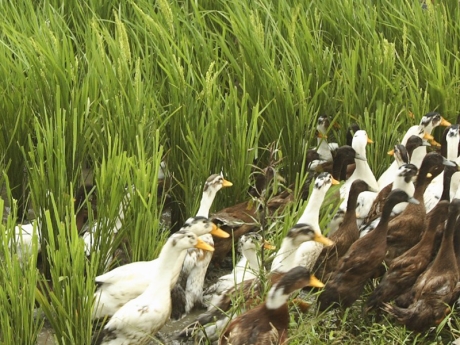
Agroecology integrates crops and animals in complementary ways. Some farmers in East Asia, for example, have introduced ducks and fish into their rice paddies. The ducks eat weeds, insects, and other pests; they churn the water with their webbed feet, providing oxygen to the rice plants; and their manure fertilizes the rice and is eaten by the fish.7,8
Photo credit: Greenpeace East Asia, 2011.
What can farmers learn from nature? Agroecology (agriculture + ecology) means building the qualities of natural ecosystems into farm ecosystems, in ways that produce more food, sustainably.6 These are some examples of such qualities, and how they can be applied to agriculture:
Efficiency: The concept of “waste” does not apply in nature; rainfall and organic matter are continually recycled by natural systems. One way farmers can reduce waste and use resources more efficiently is by composting manure, crop residues, and food waste and returning it to the land, improving soil health and increasing productivity.
Self-sufficiency: While terrestrial (land-based) ecosystems require only sunlight and rainfall, farms often involve hard work and many different resources. Farming can be made less demanding, however, by letting nature do some of the work. Cultivating healthy soil, for example, can lessen or do away with the need for irrigation, pesticides, and synthetic fertilizers.
Diversity: Farmers who cultivate a diversity of plant and animal species together can benefit from the relationships between them. Chickens, for example, that are let loose on unplanted crop fields will eat weed seeds, cattle fertilize pasture with their manure as they graze, pigs can till soil with their powerful nose discs, and certain plants can provide animals with food or shelter.
Resilience: Resilience is the ability of an ecosystem to withstand or recover from floods, hurricanes, droughts, and other shocks. Farmland can be made more resilient against soil erosion (e.g., during heavy storms), for example, by planting trees and using other barriers to block heavy winds, and by plowing and planting crops perpendicular to sloping land (contour farming) to slow rainwater runoff.
Organic Agriculture
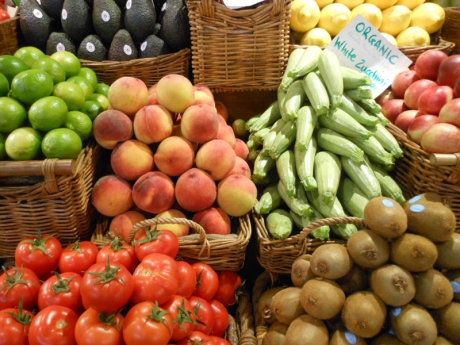
The meaning of the organic label has sparked frequent conflict. The first draft of the U.S. Department of Agriculture (USDA) organic standards, released in 1997, would have allowed the use of genetically engineered organisms, treated sewage (for fertilizing crops, see next caption), and irradiation. The public was outraged, and submitted an unprecedented number of letters (over 275,000). In response, the USDA revised the standards, which were later adopted in 2002.12
Photo credit: Michael Coghlan. Creative Commons CC BY-SA 2.0.
“Buy organic” has become a popular catchphrase among conscientious shoppers, but what exactly does the label mean?
To qualify for the U.S. Department of Agriculture (USDA) Organic label, foods (and the farms where they are produced) must meet certain requirements. For example, crops must be grown without synthetic fertilizers and certain pesticides , animals must be raised in conditions that allow them to express their natural behaviors (such as grazing on pasture), animals cannot be given hormones or antibiotics, and genetically engineered organisms are prohibited.9
Supporting organic farmers could help address many of the health and ecological problems of industrial agriculture. Organic practices could, for example, lessen agriculture’s contributions to air and water pollution, while reducing consumers’ exposure to pesticides. One study found that after children switched from conventional to organic produce, traces of chemical pesticides in their urine dropped to undetectable levels.10
Despite its benefits, the USDA Organic label has been heavily criticized for—among other reasons—moving away from the organic movement’s original ideals. Long before the USDA established its standards in 2002, organic farming pioneers in the early 1900s envisioned a movement that emphasized small-scale production and community engagement. Today, much of the organic food industry is characterized by industrial-scale farms and distributors that ship products around the globe.11,12 Many organic brands, meanwhile, are owned by some of the world’s largest corporate food manufacturers.13–15 In defense of “big organic,” Gary Hirschberg, co-founder and CEO of the Stonyfield organic dairy brand, argues that “business is the most powerful force on the planet; it got us into this mess and is the only force strong enough to get us out.16
Urban Agriculture
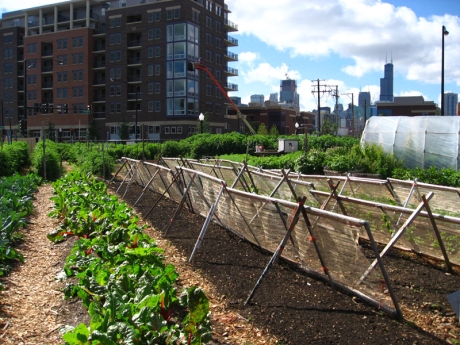
Urban farm in Chicago.
Urban farms and gardens can offer a wealth of benefits, but they alone cannot supply enough food for large cities. According to one estimate, if all the agricultural land in New York state were devoted to feeding New York City’s population, there would be only enough food to feed half the city—with nothing left for the rest of the state.29 One adult eats roughly one ton of food per year.
Photo credit: Linda N. Creative Commons CC BY 2.0.
During the First and Second World Wars, U.S. citizens were encouraged to support the war effort overseas. With everything from groceries to gasoline running in short supply, posters called on Americans to use resources efficiently by, for example, carpooling, recycling, reducing wasted food, and cutting back on meat consumption. Citizens were also asked to help out by growing some of their own food in victory gardens and preserving it. In 1944, home and community gardens supplied an estimated 40 percent of the nation’s fresh vegetables.17, 18
Today, the spirit of victory gardens lives on in the farms and community gardens that occupy urban spaces, where growers put hands to soil to make the most of every square foot. While perhaps not as prolific as during WWII, urban agriculture represents a growing movement toward transforming vacant lots, backyards, and even rooftops into productive green spaces.
Urban agriculture has the potential to offer a wealth of benefits. Studies suggest urban community gardens, for example, improve access to fresh produce,19-22 help gardeners save money on food,23,24 and foster stronger communities.23,25 Like any urban green space, urban farms and gardens can help improve air quality, moderate temperatures, and reduce storm water runoff.26,27 For many inner-city residents, urban farms and gardens may also be the only places where they can regularly experience nature.
Growing food in urban settings may also pose health risks. Urban soils may harbor contaminants such as heavy metals and petroleum products—often left over from previous businesses occupying the land. People may come into contact with these contaminants if they work or play in contaminated soil, or eat food that was grown in it. Urban growers can minimize the risks of exposure by testing their soil for contaminants, knowing the history of how their land was used, and following recommended practices, such as thoroughly washing and peeling vegetables.28
Resources
This list is a starting point for further exploration. Some materials may not reflect the views of the Johns Hopkins Center for a Livable Future.
For teachers
- Turning Toward Sustainability (lesson plan). FoodSpan. Johns Hopkins Center for a Livable Future.
- Introduction to the US Food System: Public Health, Environment, and Equity (textbook). Neff RN (editor). Johns Hopkins Center for a Livable Future. 2014.
Reports
- Vacant Lots to Vibrant Plots: A Review of the Benefits and Limitations of Urban Agriculture. Santo R, Palmer A, Kim B. Johns Hopkins Center for a Livable Future. 2016.
- Integrating Urban Farms into the Social Landscape of Cities: Recommendations for Strengthening the Relationship between Urban Farms and Local Communities. Poulsen MN, Spiker ML. Johns Hopkins Bloomberg School of Public Health. 2014.
- Soil Safety Resource Guide for Urban Food Growers. Johns Hopkins Center for a Livable Future. 2014.
- Toward Sustainable Agricultural Systems in the 21st Century. National Academy of Sciences. 2010.
- Agroecology and the Right to Food: Report Submitted by the Special Rapporteur on the Right to Food. Olivier De Schutter. United Nations. 2010.
Films and videos
- Out to Pasture: The Future of Farming? Johns Hopkins Center for a Livable Future and the Maryland Institute College of Art (MICA). 2010.
- What Is Resilience? Stockholm Resilience Centre. 2015.
Academic journal articles
- Food System Policy, Public Health, and Human Rights in the United States. Shannon KL, Kim BF, et al. Annual Review of Public Health. 2015.
- Urban Agriculture: A Global Analysis of the Space Constraint to Meet Urban Vegetable Demand (open access). Martellozzo F, Landry J-S, et al. Environmental Research Letters. 2014.
- Increasing cropping system diversity balances productivity, profitability and environmental health (open access). Davis A, Hill J, et al. PLOS One. 2012.
- Fruit and Vegetable Intake among Urban Community Gardeners. Alaimo K, Packnett E, et al. Journal of Nutrition Education and Behavior. 2008.
- Ecological agriculture: Principles, practices, and constraints (open access). Magdoff F. Renewable Agriculture and Food Systems. 2007.
- Organic Diets Significantly Lower Children’s Dietary Exposure to Organophosphorus Pesticides (open access). Lu C, Toepel K, Irish R, et al. Environmental Health Perspectives. 2006.
- How Sustainable Agriculture Can Address the Environmental and Human Health Harms of Industrial Agriculture (open access). Horrigan L, Lawrence RS, Walker P. Environmental Health Perspectives. 2002.
References
-
Berry W. The Unsettling of America: Culture & Agriculture. San Francisco, CA: Sierra Club Books; 1996.
-
Pew Commission on Industrial Farm Animal Production. Putting Meat on the Table: Industrial Farm Animal Production in America.; 2008.
-
Bruntland G. Our Common Future: Report of the World Commission on Environment and Development. Oxford University Press: Oxford; 1987.
-
Ikerd JE. Crisis & Opportunity: Sustainability in American Agriculture. Lincoln, NE: University of Nebraska Press; 2008.
-
USDA NRCS. Sustainable Agriculture - Case Studies. 1997.
-
Magdoff F. Ecological agriculture: Principles, practices, and constraints. Renew Agric Food Syst. 2007;22(02):109.
-
Miller L. Duck power and a tale of success: From six acres to an ecosystem. Leopold Lett. 2002.
-
Man LH. Duck-Fish Integration in Vietnam. In: Mukherjee TK, Moi PS, Panandam JM, Yang YS, eds. Proceedings of the FAO/IPT Workshop on Integrated Livestock-Fish Production Systems. Hanoi, Vietnam: UN FAO; 1992.
-
McEvoy M. Organic 101: What the USDA Organic Label Means. USDA Blog. 2012.
-
Lu C, Toepel K, Irish R, Fenske R a., Barr DB, Bravo R. Organic Diets Significantly Lower Children’s Dietary Exposure to Organophosphorus Pesticides. Environ Health Perspect. 2006;114(2):260-263.
-
Johnston J, Biro A, MacKendrick N. Lost in the supermarket: the corporate-organic foodscape and the struggle for food democracy. Antipode. 2009;41(3):509-532.
-
Delind LB. Transforming organic agriculture into industrial organic products: reconsidering national organic standards. Hum Organ. 2000;59(2).
-
Howard PH. Organic processing industry structure. Inf Graph. 2011. https://philhoward.net/2020/09/24/organic-processing-industry-structure-2020/June 3, 2011.
-
. Howard PH. Consolidation in the North American organic food processing sector, 1997 to 2007. Int J Sociol Agric Food. 2009;16(1):13-30.
-
Lappé A, The Coup.org. Grub Graphics. Eat Grub. 2011. http://www.eatgrub.org/?page_id=16. Accessed June 3, 2011.
-
Hirshberg G. Stirring It Up: How to Make Money and Save the World. New York: Hyperion Books; 2008.
-
Brown KH, Jameton AL. Public health implications of urban agriculture. J Public Health Policy. 2000;21(1):20-39.
-
Okvat HA, Zautra AJ. Community gardening: a parsimonious path to individual, community, and environmental resilience. Am J Community Psychol. 2011;47(3-4):374-387.
-
Alaimo K, Packnett E, Miles RA, Kruger DJ. Fruit and vegetable intake among urban community gardeners. J Nutr Educ Behav. 2008;40(2):94-101.
-
Blair D, Giesecke CC, Sherman S. A dietary, social and economic evaluation of the Philadelphia Urban Gardening Project. J Nutr Educ. 1991;23(4).
-
McCormack LA, Laska MN, Larson NI, Story M. Review of the nutritional implications of farmers’ markets and community gardens: a call for evaluation and research efforts. J Am Diet Assoc. 2010;110(3):399-408.
-
Litt JS, Soobader M-J, Turbin MS, Hale JW, Buchenau M, Marshall JA. The influence of social involvement, neighborhood aesthetics, and community garden participation on fruit and vegetable consumption. Am J Public Health. 2011;101(8):1466-1473.
-
Patel IC. Gardening’s socioeconomic impacts. J Ext. 1991;29(4).
-
Wakefield S, Yeudall F, Taron C, Reynolds J, Skinner A. Growing urban health: community gardening in South-East Toronto. Health Promot Int. 2007;22(2):92-101.
-
Kuo FE, Sullivan WC, Coley RL. Fertile Ground for Community: Inner-City Neighborhood Common Spaces. Am J Community Psychol. 1998;26(6).
-
Bolund P, Hunhammar S. Ecosystem services in urban areas. Ecol Econ. 1999;29(2):293-301.
-
Andersson E, Barthel S, Ahrné K. Measuring social-ecological dynamics behind the generation of ecosystem services. Ecol Appl A Publ Ecol Soc Am. 2007;17(5):1267-1278.
-
Johns Hopkins Center for a Livable Future. Soil Safety Resource Guide for Urban Growers. 2014.
-
Peters CJ, Bills NL, Lembo AJ, Wilkins JL, Fick GW. Mapping potential foodsheds in New York State: a spatial model for evaluating the capacity to localize food production. Renew Agric Food Syst. 2008;24(1):72-84.
